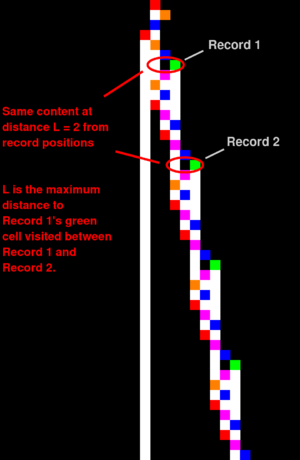Translated cycler: Difference between revisions
don't claim that skelet 1 is the largest known example |
move paragraphs, bold name |
||
| Line 1: | Line 1: | ||
[[File:Translated_cycler_44394115_annotated.svg|right|thumb|Example "Translated cycler": 45-step space-time diagram of bbchallenge's machine {{TM|44394115}}. The same bounded pattern is being translated to the right forever. The text annotations illustrate the main idea for recognising "Translated Cyclers": find two configurations that break a record (i.e. visit a memory cell that was never visited before) in the same state (here state D) such that the content of the memory tape at distance L from the record positions is the same in both record configurations. Distance L is defined as being the maximum distance to record position 1 that was visited between the configuration of record 1 and record 2.]] | [[File:Translated_cycler_44394115_annotated.svg|right|thumb|Example "Translated cycler": 45-step space-time diagram of bbchallenge's machine {{TM|44394115}}. The same bounded pattern is being translated to the right forever. The text annotations illustrate the main idea for recognising "Translated Cyclers": find two configurations that break a record (i.e. visit a memory cell that was never visited before) in the same state (here state D) such that the content of the memory tape at distance L from the record positions is the same in both record configurations. Distance L is defined as being the maximum distance to record position 1 that was visited between the configuration of record 1 and record 2.]] | ||
A '''translated cycler''' has two configurations that break a record (i.e. visit a memory cell that was never visited before) in the same state such that the content of the memory tape at distance L from the record positions is the same in both record configurations. Distance L is defined as being the maximum distance to record position 1 that was visited between the configuration of record 1 and record 2. | |||
A translated cycler has two configurations that break a record (i.e. visit a memory cell that was never visited before) in the same state such that the content of the memory tape at distance L from the record positions is the same in both record configurations. Distance L is defined as being the maximum distance to record position 1 that was visited between the configuration of record 1 and record 2. | |||
Here are the properties of the translated cycler shown in the figure: | Here are the properties of the translated cycler shown in the figure: | ||
| Line 11: | Line 9: | ||
* The '''cycle offset''' is 2 symbols to the right. In other words, after each cycle, the TM moves 2 places to the right. | * The '''cycle offset''' is 2 symbols to the right. In other words, after each cycle, the TM moves 2 places to the right. | ||
* The '''cycle start time''' is 6 steps. This is the position of record 1. | * The '''cycle start time''' is 6 steps. This is the position of record 1. | ||
Translated cyclers are close to [[Cycler|Cyclers]] in the sense that they are only repeating a pattern but there is added complexity as they are able to translate the pattern in space at the same time, hence the decider for Cyclers cannot directly apply here. | |||
== Notable translated cyclers == | == Notable translated cyclers == | ||
[[Skelet 1]] is a translated cycler that has a period of 8,468,569,863 steps, an offset of 107,917 symbols to the right, and a start time of at least <math>10^{24}</math>. | [[Skelet 1]] is a translated cycler that has a period of 8,468,569,863 steps, an offset of 107,917 symbols to the right, and a start time of at least <math>10^{24}</math>. | ||
Revision as of 03:20, 24 July 2024

44394115 (bbch). The same bounded pattern is being translated to the right forever. The text annotations illustrate the main idea for recognising "Translated Cyclers": find two configurations that break a record (i.e. visit a memory cell that was never visited before) in the same state (here state D) such that the content of the memory tape at distance L from the record positions is the same in both record configurations. Distance L is defined as being the maximum distance to record position 1 that was visited between the configuration of record 1 and record 2.A translated cycler has two configurations that break a record (i.e. visit a memory cell that was never visited before) in the same state such that the content of the memory tape at distance L from the record positions is the same in both record configurations. Distance L is defined as being the maximum distance to record position 1 that was visited between the configuration of record 1 and record 2.
Here are the properties of the translated cycler shown in the figure:
- L = 2. After the translated cycler reaches record 1, the translated cycler moves at most L = 2 symbols to the left.
- The cycle period is 10 steps. This is the number of steps from record 1 to record 2.
- The cycle offset is 2 symbols to the right. In other words, after each cycle, the TM moves 2 places to the right.
- The cycle start time is 6 steps. This is the position of record 1.
Translated cyclers are close to Cyclers in the sense that they are only repeating a pattern but there is added complexity as they are able to translate the pattern in space at the same time, hence the decider for Cyclers cannot directly apply here.
Notable translated cyclers
Skelet 1 is a translated cycler that has a period of 8,468,569,863 steps, an offset of 107,917 symbols to the right, and a start time of at least .